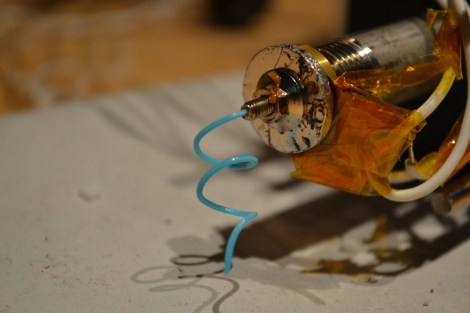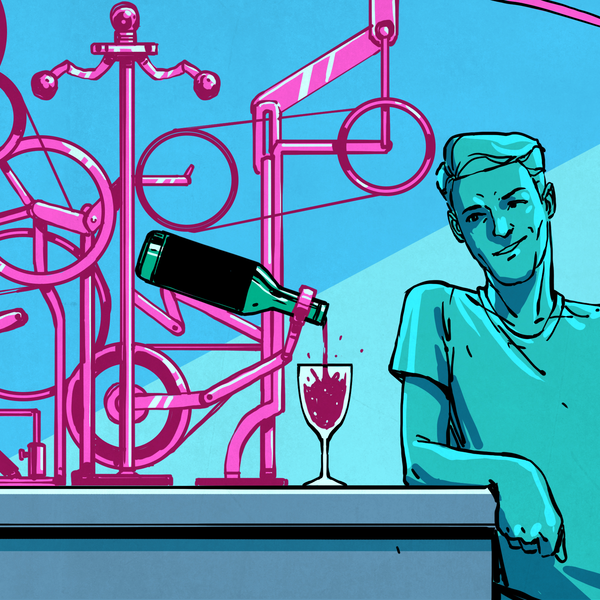
The holy grail of desktop 3D printers – aside from manufacturing full color objects in any shape imaginable – is turning tiny plastic pellets into a plastic filament. Many projects have attempted this with moderate levels of success but turning pellets into filament still an open problem. MakiBot hopes to solve this problem by manufacturing plastic filament just in time to be squirted out a nozzle onto the print bed.
MakiBox is seeing a lot of potential with their pellet drive. Instead of sending huge amounts of pellets into an auger extruder, the team realized the best option would be to send pellets into the hot end one at a time. This makes for better thermal characteristics and produces a very consistent filament.
Turning plastic pellets into 3D objects is an enticing idea but producing a filament on the fly is an interesting concept. While the MakiBox team is making custom color filament right now, in the future it might be possible to mix colors for full-color prints.
Videos demonstrating the extruder after the break.
[youtube=http://www.youtube.com/watch?v=zAOFzZPbPnk&w=470]
[youtube=http://www.youtube.com/watch?v=QbAvFufDP-0&w=470]















It looks very promising, but I wonder if it will be hard to get consistent results due to the plastic becoming brittle or otherwise compromised if things aren’t just right.
Also, I’d argue the holy grail is atomically identical copies of objects, not just printing in full color (something that can already be done w/ expensive printers).
Are you from the future? I don’t think we can print anything identical at the atomic scale of any appreciable size…
Maybe he drives a DeLorean? :P
Yet… think in terms of massively parallel scanning tunneling microscope type devices, able to pick and place molecules. First job, print your own 256 core CPU…
IBM wrote their name with 36 atoms. Last I checked it was a worlds record. As far as doing it practically though, I haven’t heard anything about that yet.
If you were sufficiently motivated, you could build a basic STM in your basement… not in your attic though, too much vibration. Would take a while to get progress with it though, need to vacuum pump it for 24 hours or so every time you crack it open to change something before you could test it. Then if you figured out a multi tip probe, you’d probably have to leave several atoms spacing between tips or they’d interfere with each other. Plus you’d have to start everything on a single plane atom substrate, a cleaved regular crystal, other surfaces would be too rough. Getting all the probes to the same length would be quite a challenge in itself. Possibly you’d want to spend 6 months with a regular STM building the head of your STM probe array., even with an “atomic megapixel” you’d take a long while to build anything visible.
Restricting to 1 grain at a time is a very good idea but are plastic grains standardized? I was under the impression they were pretty randomly shaped.
The ones I’ve seen are pretty close to the same size. Close enough to be able to design for it.
Depends if they are straight from the ‘mill’ and clean, or if they are re-grind.
However there are still a number of issues, not least of which is the pellets are deliquescent.
Which means in a big molding house you have tor dry and dehumidify for 24 hours, then load into an attachment that continues to extract water before the pellets are fed into the screw of the plastic molding machine.
ive heard the same thing said about just using weed whacker line in a 3d printer
Yup. Also experienced by people who tried to print polycarbonate (comes out milky white). It needs to be dried for a long while before printing.
I’ve had this one on my radar for a few months now…last I checked he was expecting to ship at the end of October, but I see that he has removed that from his website now :(
Oh well, can’t rush good products!
This is a hell of a great thing! I sure hope they can get into production soon!
You’d need to feed the pellets in off-center I bet, above the screwthread instead of the axis.
But I’m just guessing.
Perhaps you could do away with the print head entierly.
A tube for each bead colour and a device to order the colours in a buffer ahead of the extruder. Then extrude directly to the work peice.
Say red, yellow, blue, black and white. Each gets indevidually “icecream scooped” into a grinder mixed and then melted.
Why melt it twice. Why store both filiment and beads.
I think that is what they are trying to do here, especially since they are trying to control the output, which would be pointless if you just wanted an endless filament.
My understanding is that the idea is to keep as much weight as possible away from the print head, since that has to be very mobile.
If you fed pellets to the print head, then you’d definitely need a motor up there to drive the extruder system. You’d also need either a motor that can push pellets from the storage bin up to the print head (somewhat tricky; it’d be very easy for the whole thing to jam up) or a storage bin on the print head (which increases size and weight).
Converting the pellets to a filament in the base of the printer resolves that. The filament can be fed to the print head using a Bowden tube (just like most other printers use) and no motors are required on the print head.
Regarding the different colours: I suspect that one pellet will provide for an inch or more of linear printing. As a result, if you were doing colours by feeding in different pellets at just the right time, it wouldn’t be possible to print fine details.
I think the current plan (once the Makibox is shipping) is to look at adding a second extruder, which would allow for fairly high resolution changes in material.
Then maybe the solution is a giant FIXED head with a heated bed that moves in the X-Y-Z directions? (not a 3D printer designer, just throwing ideas)
When Jon switched from a traditional filament feed to pellet feed design back in June, it almost caused a revolution. The project was already a few months late, and pellets were a hard sell.
But Jon was in fact, well informed of the issues he was facing, and he solved them one by one. Voids in the filament? That ended two weeks ago. Brittle filament? Solved this past week. All of the tuning and adjusting that typically goes into a reprap project is being investigated and solved by his team. It’s likely this will be one of the first “bolt it together and print” 3d printers to hit the market. Yeah, the project is closer than not to a year late, but while he developed the printer, he also built a company and worked out a sustainable, and expandable assembly process. When the first Makibox print videos are posted and all you “wait and see” folks slam Makible with orders–You won’t be waiting months for delivery. The hard stuff has been worked out already.
Thanks for the Reply @Dances … to clarify (again) – we’re not late, that’s just the one big misunderstanding/miscommunication we will have to deal with (forever?): When we announced the MakiBox Funding/the Box, we didn’t had a working Prototype and Jon was, well, a tiny bit to enthusiastic ^_^
Anyway: We’re getting close to shipping the Alpha Units and setting up Documentation and all the tiny little things needed backstage to ship a damn good solid Product. Thank you all for taking this ride with us.
Print On!
That’s exactly how the 3D Printing must have been ages ago.
That’s what i thought it would be before i even hear about 3D Printing.
Feed a bin with Pellets and get your model in plastic!
Not only you have to through a journey to either get or make your own 3D Printer but you also need a few dozens of dollars for fillament while you can print a Cruish Ship with the same money on Pellets.
I’m glad to see someone experimenting on this.
All injection moulding is done with pelletised thermo plastics, it makes logical sense to do this with extrusion based 3D printers.
INCORRECT!!!!
Injection molding is done with:
1. pure pellets.
2. regrind.
3 Pellets + regrind.
It all depends on what you are molding and the final cost of the product.
no one ever tried 3d printing with epoxy ink?
Or wax?
Molding with regrind introduces some differences into the items made with the twice melted plastic.
Mostly the difference is increased brittleness and reduced strength.
You can either design your product to work with the altered properties or you can adjust the temperature and pressure as well as include “virgin” plastic and/or additives to get as close to the plastic’s original properties as possible.
Printing directly from pellets should produce better objects than printing with filament that was made from pellets.
How much strength is lost in a regrind? And why does that happen? Does the material break down with repeated melting?
Dirk vander Kooij already did this with recycled plastic chips: http://www.youtube.com/watch?v=FvRTHynk9KA
I think the plastic chips in the bin could easily be replaced with pallets.
But you will need a very strong machine.
* pallet => pellet
Agreed. It would have to be a very strong machine :P
http://upload.wikimedia.org/wikipedia/commons/7/74/Wooden_pallet_with_glove.jpg
Call me when I can just throw my empty plastic containers in.
Makibox is toast. In the years since this posting it has gone down hill fast.